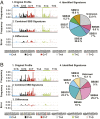A high-resolution landscape of mutations in the BCL6 super-enhancer in normal human B cells
- PMID: 31748270
- PMCID: PMC6900602
- DOI: 10.1073/pnas.1914163116
A high-resolution landscape of mutations in the BCL6 super-enhancer in normal human B cells
Abstract
The super-enhancers (SEs) of lineage-specific genes in B cells are off-target sites of somatic hypermutation. However, the inability to detect sufficient numbers of mutations in normal human B cells has precluded the generation of a high-resolution mutational landscape of SEs. Here we captured and sequenced 12 B cell SEs at single-nucleotide resolution from 10 healthy individuals across diverse ethnicities. We detected a total of approximately 9,000 subclonal mutations (allele frequencies <0.1%); of these, approximately 8,000 are present in the BCL6 SE alone. Within the BCL6 SE, we identified 3 regions of clustered mutations in which the mutation frequency is ∼7 × 10-4 Mutational spectra show a predominance of C > T/G > A and A > G/T > C substitutions, consistent with the activities of activation-induced-cytidine deaminase (AID) and the A-T mutator, DNA polymerase η, respectively, in mutagenesis in normal B cells. Analyses of mutational signatures further corroborate the participation of these factors in this process. Single base substitution signatures SBS85, SBS37, and SBS39 were found in the BCL6 SE. While SBS85 is a denoted signature of AID in lymphoid cells, the etiologies of SBS37 and SBS39 are unknown. Our analysis suggests the contribution of error-prone DNA polymerases to the latter signatures. The high-resolution mutation landscape has enabled accurate profiling of subclonal mutations in B cell SEs in normal individuals. By virtue of the fact that subclonal SE mutations are clonally expanded in B cell lymphomas, our studies also offer the potential for early detection of neoplastic alterations.
Keywords: BCL6; duplex sequencing; mutational signatures; somatic hypermutation; super-enhancer.
Conflict of interest statement
Competing interest statement: L.A.L. is a founder and equity holder at TwinStrand Biosciences.
Figures




References
-
- Klein U., Dalla-Favera R., Germinal centres: Role in B cell physiology and malignancy. Nat. Rev. Immunol. 8, 22–33 (2008). - PubMed
-
- Victora G. D., Nussenzweig M. C., Germinal centers. Annu. Rev. Immunol. 30, 429–457 (2012). - PubMed
-
- Peled J. U., et al. , The biochemistry of somatic hypermutation. Annu. Rev. Immunol. 26, 481–511 (2008). - PubMed
-
- Liu M., et al. , Two levels of protection for the B cell genome during somatic hypermutation. Nature 451, 841–845 (2008). - PubMed
Publication types
MeSH terms
Substances
Grants and funding
LinkOut - more resources
Full Text Sources
Miscellaneous

